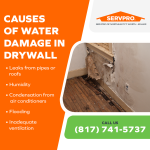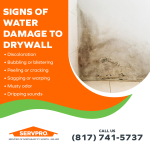Water damage is a common problem in homes, especially during natural disasters or when there are plumbing issues. Drywall is one of the most common materials that get damaged by water. The good news is that it can be repaired, depending on the extent of the damage. In this blog, we will dive into whether water-damaged drywall can be repaired and what steps you can take to ensure a successful repair.
Water damage in drywall can be a big problem for homeowners, and it's vital to know how to identify and repair it. Leaks and moisture can cause significant damage to the walls, and it's crucial to act quickly to prevent further damage. SERVPRO of Northeast Ft. Worth - Keller explains what to do when water damage affects drywall.

SERVPRO of Northeast Ft. Worth - Keller is a premiere fire and water cleanup and restoration company. This business is locally owned and operated, providing emergency services 24/7. As a leader in the restoration industry, their water damage restoration services in Keller are the most trusted.
Causes of Water Damage in Drywall
Water damage in drywall can be caused by a variety of factors, including:
- Leaks from pipes or roofs
- Humidity
- Condensation from air conditioners
- Flooding
- Inadequate ventilation
It's important to identify the source of the water damage to prevent future issues. Moisture can infiltrate drywall and create an environment conducive to mold growth, leading to health issues for building occupants. Water damage can compromise the drywall's structural integrity and impact a space's overall aesthetics.
Signs of Water Damage To Drywall
- Discoloration: Water damage can cause the paint or wallpaper on the drywall to become discolored, often with brown or yellowish stains.
- Bubbling or blistering: Water damage can cause the drywall to bubble or blister, creating a rough or uneven surface.
- Peeling or cracking: When water seeps into the drywall, it can cause the surface to peel or crack, especially around the edges.
- Sagging or warping: If the drywall is exposed to water for an extended time, it may start to sag or warp, which can be a sign of serious damage.
- Musty odor: Water damage can also create a musty smell, especially if the water has been present for some time and has started to develop mold or mildew.
- Dripping sounds as if from within the walls.
Identifying leaks and moisture is critical in preventing further damage to your building and effectively repairing water-damaged drywall.
Water damage restoration of drywall
The following are the general steps that may be taken for water damage restoration of drywall:
- Inspection: A professional water damage restoration company like SERVPRO of Northeast Ft. Worth - Keller will first inspect the extent of the water damage and determine the best course of action for complete restoration.
- Water removal: Any standing water will be removed using specialized equipment such as powerful pumps and vacuums to prevent secondary water damage and mold growth.
- Drying and dehumidification: The affected area will be dried thoroughly using air movers and dehumidifiers. This limits the risk of further damage and mold growth.
- Removal of drywall: Any irreversibly damaged or moldy drywall will be removed and disposed of properly to minimize the risk of spreading contaminants.
- Cleaning: The remaining surfaces and restorable items and structures will be cleaned and disinfected using specialized equipment and cleaning solutions. The professionals at SERVPRO of Northeast Ft. Worth - Keller are trained to provide sanitizing treatments and deodorize affected property.
- Restoration: Once the area is dry and clean, the damaged drywall will be replaced and painted to match the surrounding areas. The restoration process aims to restore a home or business to a pre-loss condition.
- Prevention: To prevent future water damage, the restoration company may recommend measures such as installing a sump pump or sealing any cracks or leaks in the foundation or walls.
DIY vs. Professional Drywall Repair: Pros and Cons.
DIY enthusiasts can attempt to repair water-damaged drywall. You'll need a utility knife, a drywall saw, sandpaper, and a putty knife. You have to cut out the damaged drywall and clean the area thoroughly before applying a new layer of joint compound and sanding it down to be flush with the surrounding drywall. Some techniques that could prove useful include using fans or dehumidifiers to speed up the drying process and also applying a mold and mildew-resistant primer after the repair is complete.
While tackling drywall repair as a DIY project may seem more cost-effective, certain repairs require specialized tools and techniques only a professional may possess. Additionally, poor repairs done by inexperienced individuals may result in sub-par quality and need further repairs. Professionals have the necessary knowledge and experience to provide high-quality, long-lasting repairs.
DIY can be challenging. It is also not as efficient and reliable as water damage repair by experienced professionals.
Tips for Preventing Water Damage in Drywall
- Fix leaks promptly
- Seal cracks and gaps
- Inspect and maintain appliances
- Install a sump pump
- Check gutters and downspouts
- Monitor humidity levels and use a dehumidifier to maintain a healthy level of humidity
- Insulate pipes

Why Choose SERVPRO of Northeast Ft. Worth - Keller
SERVPRO of Northeast Ft. Worth - Keller is the #1 choice for water damage restoration in Keller, Texas. They always do what is right by the customer and, as part of a nationwide network of 1,700 franchises, can respond quickly to any size disaster with more resources. If you are looking for an experienced and reliable water damage restoration company in Keller, contact SERVPRO of Northeast Ft. Worth - Keller at (817) 741-5737.




























